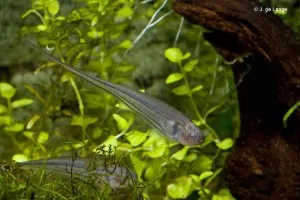Anostomus ternetzi – Ternetzi Headstander
Anostomus ternetzi was first described in 1949 by Fernández and Yépez. They are part of the Anostomidae family or the Headstanders. They are called this way because the fish often swim around with their heads down at an angle of 45 degrees. They have long been known in the hobby. From 1965 they are imported under the current name, possibly they were also imported earlier, but then under a different name.
The genus name Anostomus is made up of two ancient Greek words. Ana means up and stoma means mouth. A reference to this genus upward-facing beak. This species is named after Dr Carl Ternetz, hence the generic name ternetzi.
The genus Anostomus has five species of which only Anostomus anostomus and Anostomus ternetzi regularly occur in the aquarium hobby.
Description
With a maximum length of around 12 centimetres, Anostomus ternetzi stays somewhat smaller than its larger cousin, Anostomus anostomus, which can reach a length of around 16 centimetres. They have an elongated body. On the body are white/beige and brown horizontal stripes with a black spot on the caudal peduncle. The fins are transparent. A very small amount of red is visible around the mouth and gills.
The difference between the sexes is not clearly visible. The horizontal stripes on young animals are not completely straight. It seems as if the stripes consist of several connected dots. As the animals get older the stripes become straight. For some of the fish, the line remains somewhat bumpy. Probably this is an indication it is a female. With several fish species, it can be seen that the striped pattern in females is more similar to that of juveniles.
Character
The character depends a bit on the size of the aquarium and the group. In a small aquarium with only a few specimens, they show mutual aggression. In a somewhat larger aquarium in a group of about seven specimens, they show more natural school-forming behaviour. The mutual aggression that is often visible with Anostomus species is more caused by keeping these fish in a too small a group and in an aquarium that is too small. They are generally peaceful towards other species.
Biotope
The distribution area of Anostomus ternetzi includes rivers in Brazil, French Guiana, Guyana, Suriname and Venezuela. They inhabit the fast-flowing, rocky parts of the rivers and streams that are part of the Amazon, Rio Orinoco, Rio Araguaia and Rio Machado.
Diet
In the wild, Anostomus ternetzi feeds by grazing algae on rocks and plants. Small invertebrates are also eaten. It is, therefore, an omnivore but mainly eats vegetable food.
In the aquarium, it must therefore be fed with mainly herbivorous food, such as spirulina flakes, wafers, cucumber, lettuce, blanched (fresh) spinach, etc. Alternate this with the occasional live or frozen food and normal flakes.
Anostomus ternetzi Aquarium
Because the Ternetzi Headstander actually needs to be kept in a group, a large aquarium is needed from about 150 centimetres. Decorate the aquarium with (filter) sand on the bottom, wood, stones and sturdy plants such as Anubias, Echinodorus and Java Fern. Because they scrape algae from the plants, soft plants do not survive. They eat the soft parts of these plants that will eventually die.
They are fast swimmers and can jump out of the water when they are scared. Always ensure that you have a lid on the aquarium to prevent your fish from jumping out of the aquarium.
As co-residents, you can choose larger species such as (peaceful) cichlids, characins and Loricariidae.
Video
Author
John de Lange
Copyright images
Resources
AquariumGlaser.de
SeriouslyFish.com
Mergus Aquarien Atlas – auflage 8 – pagina 236

















Reviews
There are no reviews yet.